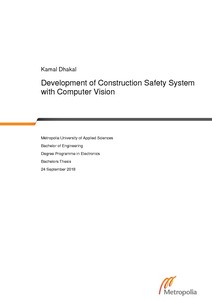Development of Construction Safety System with Computer Vision
Dhakal, Kamal (2018)
Julkaisun pysyvä osoite on
https://urn.fi/URN:NBN:fi:amk-2018092415351
https://urn.fi/URN:NBN:fi:amk-2018092415351
Tiivistelmä
This Bachelors Thesis explores the emerging field of automation technology to develop an advanced driver assistant system for the safety of construction workers in a construction site. The main goal of this study is to use different computer vision and machine learning algorithms to develop an autonomous system which alarms the driver of an excavator when construction workers are in near proximity of the vehicle.
The study evaluates different types of state of the art technologies for the development of vision-based detection and tracking system for the occupational safety of construction workers. The study includes the development of hardware system, and a software module for the operation of developed hardware unit. A stereo rig with two individual camera modules with high power LED rings around them is designed as a hardware unit. The software module is based on the algorithms of computer vision and machine learning for the effective operation of the stereo system to detect and track construction workers with safety vest on their body.
The developed system was tested in different indoor and outdoor environmental conditions. The real-time tracking and detection of persons with reflective vest on their body was successfully conducted. The camera module was placed in test environment and the persons with safety vest on their body were exposed to the field of view of camera module. The system performed extremely well in the indoor conditions and outdoor conditions with minimum sunlight facing the camera. The system showed satisfactory results in bright morning and evening conditions. The results were comparatively poor when a camera module was exposed directly towards the sun during the test conducted in mid-day of the summer season. The evaluation results were based on the real-time tests which were conducted in indoor hall and outdoor yard of a building in different times of the day. The system is yet to be tested in the real-world construction area with excavators and heavy machinery equipment.
The study concludes that the approach used in this study could be the effective solution to minimize accidents and risk hazards in the construction industry. The application of advanced machine learning technologies developed in the recent times will continue to push the development of this system further forward
The study evaluates different types of state of the art technologies for the development of vision-based detection and tracking system for the occupational safety of construction workers. The study includes the development of hardware system, and a software module for the operation of developed hardware unit. A stereo rig with two individual camera modules with high power LED rings around them is designed as a hardware unit. The software module is based on the algorithms of computer vision and machine learning for the effective operation of the stereo system to detect and track construction workers with safety vest on their body.
The developed system was tested in different indoor and outdoor environmental conditions. The real-time tracking and detection of persons with reflective vest on their body was successfully conducted. The camera module was placed in test environment and the persons with safety vest on their body were exposed to the field of view of camera module. The system performed extremely well in the indoor conditions and outdoor conditions with minimum sunlight facing the camera. The system showed satisfactory results in bright morning and evening conditions. The results were comparatively poor when a camera module was exposed directly towards the sun during the test conducted in mid-day of the summer season. The evaluation results were based on the real-time tests which were conducted in indoor hall and outdoor yard of a building in different times of the day. The system is yet to be tested in the real-world construction area with excavators and heavy machinery equipment.
The study concludes that the approach used in this study could be the effective solution to minimize accidents and risk hazards in the construction industry. The application of advanced machine learning technologies developed in the recent times will continue to push the development of this system further forward

